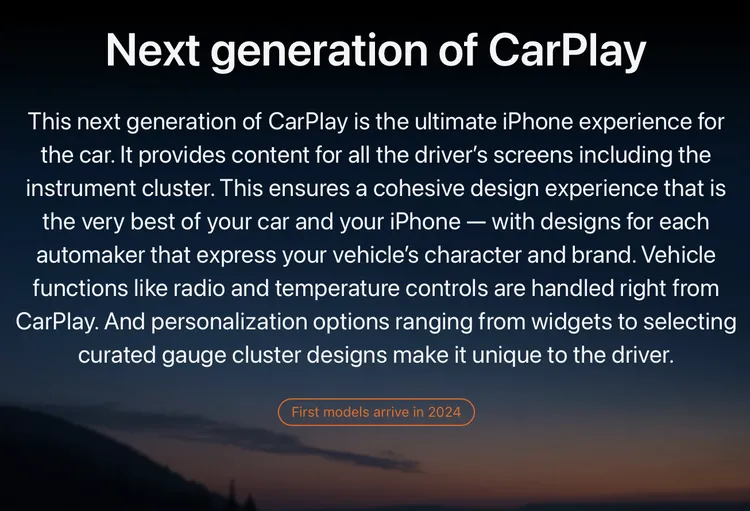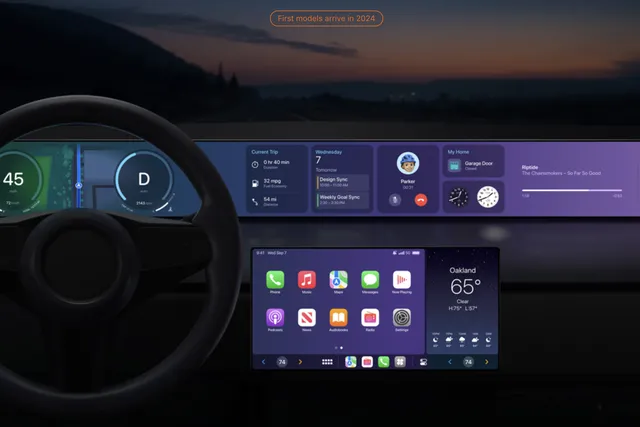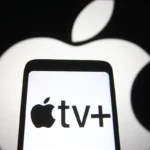Two and a half years after it was announced, there are still no cars with next-gen CarPlay on the horizon.
It’s been over two years since Apple first unveiled its ambitious vision for the “next generation of CarPlay” during WWDC 2022. At the time, Apple promised a sweeping transformation of in-car infotainment systems, touting a design that would integrate seamlessly across multiple screens, including instrument clusters, and provide a unified, Apple-style interface for everything from navigation to climate control. The rollout was slated for 2024, a date Apple continues to display prominently on its CarPlay webpage.
But here we are, teetering on the edge of 2025, and there’s still no sign of the next-gen CarPlay. So, what’s the holdup? Let’s dive into the current state of CarPlay, the challenges it’s facing, and why Apple’s grand vision might be stuck in neutral.
Incremental Changes, Not Revolution
Since the announcement, the advancements in CarPlay have been, well, underwhelming. While we’ve seen incremental updates—such as CarPlay navigation directions being displayed in the instrument cluster on select vehicles from Polestar, Porsche, and Lincoln—these updates are a far cry from the dashboard-dominating, multi-screen experience Apple showcased in 2022.
Take the 2024 Lincoln Nautilus, for example. The vehicle boasts an expansive display that seems tailor-made for Apple’s envisioned CarPlay upgrade. Yet, it still lacks the full-fledged next-gen software. Similarly, Porsche and Aston Martin were initially expected to lead the charge with Apple’s new CarPlay experience. However, both brands recently declined to provide Wired with a timeline for its rollout, casting further doubt on when—or if—the new system will arrive.

Automaker Resistance: A Roadblock to Apple’s Vision
Part of the delay can be attributed to automakers themselves. While Apple’s presentation initially boasted a long list of manufacturers committed to the new CarPlay—including Ford, Mercedes-Benz, and Honda—many have since gone quiet or outright distanced themselves from the idea.
For instance, Mercedes-Benz CEO Ola Källenius bluntly told The Verge’s Nilay Patel in April that Apple would not be taking over all the screens in its cars. This sentiment isn’t isolated. Automakers are increasingly wary of handing over control of their vehicles’ digital experiences to tech giants like Apple and Google. The stakes are high: infotainment systems are becoming a critical battleground for automakers to differentiate their products, and many are reluctant to cede that ground to a third party.
General Motors (GM) and Rivian have taken particularly strong stances against Apple’s next-gen CarPlay and Google’s Android Auto. GM’s decision to abandon both platforms entirely in favor of its proprietary system sparked significant backlash but underscores the company’s desire for full control over its in-car ecosystem. Rivian, meanwhile, has also steered clear, aligning itself with a similar philosophy.
Control Versus Collaboration
At the heart of this struggle is a broader industry trend: automakers are increasingly prioritizing control over their vehicles’ digital experiences. This isn’t just about branding or user interfaces. It’s about data.
Modern vehicles generate enormous amounts of data, from driving habits to navigation preferences. Tech companies like Apple and Google have a vested interest in accessing that data to refine their software and develop new revenue streams. Automakers, on the other hand, are eager to retain ownership of that data to fuel their own digital initiatives, such as subscription-based services and advanced driver-assistance features.
The result is a growing tension between automakers and tech companies. While Apple’s vision for CarPlay offers undeniable convenience and polish for consumers, it also represents a potential loss of control for automakers. And for many, that’s a dealbreaker.
Apple’s Persistent Optimism
Despite these challenges, Apple has continued to promote its next-gen CarPlay plans. The company’s WWDC 2022 presentation remains an impressive showcase of what could be: a seamless, beautifully designed interface that integrates navigation, media controls, climate settings, and more across a vehicle’s displays. Apple’s ecosystem appeal—its ability to tie your car experience to your iPhone, Apple Music, and even Apple Maps—is a compelling proposition for consumers.
But compelling doesn’t mean realistic. Without widespread automaker support, Apple’s vision may remain just that: a vision. And the automakers that have shown interest have so far failed to deliver concrete timelines or product launches, leaving consumers in limbo.
The Road Ahead
So, where does this leave next-gen CarPlay? For now, it’s stuck in the slow lane. While Apple’s ambition to redefine in-car software is admirable, the reality is far more complex. Automakers are not just partners in this endeavor; they are gatekeepers. And many are choosing to keep the gates closed.
If Apple wants its next-gen CarPlay to become a reality, it may need to rethink its approach. Greater collaboration with automakers, clearer value propositions, and perhaps even compromises on data sharing could help bridge the gap. Otherwise, we may be looking at a future where Apple’s grand vision for CarPlay remains an unfulfilled promise.
For now, drivers hoping for a truly Apple-style in-car experience will have to settle for the CarPlay we already know—functional, familiar, but far from revolutionary.










